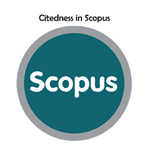Perbandingan Perlindungan Minyak Jintan Hitam, Minyak Argan dan Minyak Zaitun terhadap Enzim Hati Tikus Akibat Diet Tinggi Lemak
Abstract
Keywords
Full Text:
PDFReferences
P. O. Tan, N. Mustaffa, S. S. Tan, and Y. Y. Lee, "Diagnosis and management of fatty liver" J. R. Coll. Physicians Edinb., vol. 50, no. 3, pp. 256-261, 2020, doi: 10.4997/JRCPE.2020.308.
M. A. Van Herck, L. Vonghia, and S. M. Francque, "Animal models of nonalcoholic fatty liver disease"”a starter's guide" Nutrients, vol. 9, no. 10, pp. 1-13, 2017, doi: 10.3390/nu9101072.
Y. Duan et al., "Inflammatory links between high fat diets and diseases" Front. Immunol., vol. 9, no. NOV, pp. 1-10, 2018, doi: 10.3389/fimmu.2018.02649.
R. P. Armanto, "Deteksi Dini Perlemakan Hati Akut Dalam Kehamilan (Acute fatty liver of pregnancy (AFLP)) dan Penanganannya dengan Diet Rendah Lemak" KELUWIH J. Kesehat. Dan Kedokt., vol. 1, no. 2, pp. 81-88, 2020, doi: 10.24123/kesdok.v1i2.2593.
S. Prahastuti, J. E. Ladi, K. Dewi, F. Albertina, and M. K. Imam, "The Effect of Bee Pollen on SGOT, SGPT Levels and Liver Histopathological Images of Male Rats Wistar Induced by High Fat Diet" J. Med. Health, vol. 2, no. 5, pp. 51-60, 2020, doi: 10.28932/jmh.v2i5.2040.
M. Bakour et al., "The antioxidant content and protective effect of argan oil and syzygium aromaticum essential oil in hydrogen peroxide-induced biochemical and histological changes" Int. J. Mol. Sci., vol. 19, no. 2, 2018, doi: 10.3390/ijms19020610.
A. A. Albassam, A. Ahad, A. Alsultan, and F. I. Al-Jenoobi, "Inhibition of cytochrome P450 enzymes by thymoquinone in human liver microsomes" Saudi Pharm. J., vol. 26, no. 5, pp. 673-677, 2018, doi: 10.1016/j.jsps.2018.02.024.
M. Darand, S. M. Alavian, and A. Hekmatdoost, "Nigella sativa and non-alcoholic fatty liver disease: A review of the current evidence" Hepat. Mon., vol. 18, no. 10, 2018, doi: 10.5812/hepatmon.68046.
A. Badreddine et al., "Argan oil-mediated attenuation of organelle dysfunction, oxidative stress and cell death induced by 7-ketocholesterol in murine oligodendrocytes 158N" Int. J. Mol. Sci., vol. 18, no. 10, pp. 1-31, 2017, doi: 10.3390/ijms18102220.
F. Shidfar, S. S. Bahrololumi, S. Doaei, A. Mohammadzadeh, M. Gholamalizadeh, and A. Mohammadimanesh, "The Effects of Extra Virgin Olive Oil on Alanine Aminotransferase, Aspartate Aminotransferase, and Ultrasonographic Indices of Hepatic Steatosis in Nonalcoholic Fatty Liver Disease Patients Undergoing Low Calorie Diet" Can. J. Gastroenterol. Hepatol., vol. 2018, 2018, doi: 10.1155/2018/1053710.
M.-H. Kim, E.-J. Lee, J.-M. Cheon, K.-J. Nam, T.-H. Oh, and K.-S. Kim, "Antioxidant and hepatoprotective effects of fermented red ginseng against high fat diet-induced hyperlipidemia in rats" Lab. Anim. Res., vol. 32, no. 4, p. 217, 2016, doi: 10.5625/lar.2016.32.4.217.
A. B. Santamarina et al., "Polyphenols-rich fruit (euterpe edulis mart.) prevents peripheral inflammatory pathway activation by the short-term high-fat diet" Molecules, vol. 24, no. 9, pp. 1-14, 2019, doi: 10.3390/molecules24091655.
M. Hussain, A. G. Tunio, L. Akhtar, and G. S. Shaikh, "Effects of nigella sativa on various parameters in Patients of non-alcoholic fatty liver disease" J. Ayub Med. Coll. Abbottabad JAMC, vol. 29, no. 3, pp. 403-407, 2017.
A. Tavakkoli, V. Mahdian, B. M. Razavi, and H. Hosseinzadeh, "Review on clinical trials of black seed (Nigella sativa ) and its active constituent, thymoquinone" J. Pharmacopuncture, vol. 20, no. 3, pp. 179-193, 2017, doi: 10.3831/kpi.2017.20.021.
A. El Midaoui, Y. Haddad, Y. Filali-Zegzouti, and R. Couture, "Argan oil as an effective nutri-therapeutic agent in metabolic syndrome: A preclinical study" Int. J. Mol. Sci., vol. 18, no. 11, pp. 1-16, 2017, doi: 10.3390/ijms18112492.
K. Srinivasan, "Cumin (Cuminum cyminum) and black cumin (Nigella sativa) seeds: Traditional uses, chemical constituents, and nutraceutical effects" Food Qual. Saf., vol. 2, no. 1, pp. 1-16, 2018, doi: 10.1093/fqsafe/fyx031.
DOI: https://doi.org/10.37311/ijpe.v3i2.20104
Refbacks
- There are currently no refbacks.
Copyright (c) 2023 Liska Alfaaizin, Aryadi Arsyad, Yulia Yusrini Djabir

Indonesian Journal of Pharmaceutical Education is licensed under a Creative Commons Attribution-NonCommercial-ShareAlike 4.0 International License.



